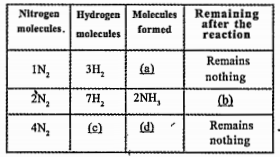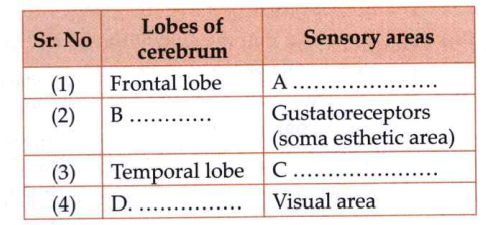N2+3H2→2NH3 Complete the followign table
 Solution in Malayalam
Solution in Malayalam
Step by step video & image solution for N_2+3H_2rarr2NH_3 Complete the followign table by Chemistry experts to help you in doubts & scoring excellent marks in Class 10 exams.
Topper's Solved these Questions
- BOOK - BODY BOOKS PUBLICATIONCHAPTER - GAS LAWS AND MOLE CONCEPTEXERCISE - EXERCISE6videos
GAS LAWS AND MOLE CONCEPT
- BOOK - BODY BOOKS PUBLICATIONCHAPTER - COMPOUNDS OF NON-METALSEXERCISE - EXERCIES7videos
COMPOUNDS OF NON-METALS
- BOOK - BODY BOOKS PUBLICATIONCHAPTER - March 2020 PaperEXERCISE - EXERCISE42videos
March 2020 Paper
Similar Questions
Identify the relation and complete: Atomic Mass of 1g carbon-12 g. Atomic Mass of 1g Oxygen………………….
05:34View SolutionFill in the blanks: Liquor ammonia: concentrated aquous solution of ammonia; Liquid ammonia:………………….
03:43View SolutionWhat is the maximum number of electrons that can be accommodated in 'f' subshell? (2,6,10,14)
04:38View SolutionFind out the correct match from the followign table :-
04:38View Solutionअभिक्रिया N2+3H2→2NH3 के लिए यदि Δ[NH3]Δt=2×10−4 मोल लीटर−1 सेकण्ड−1 हो तो का मान हो
02:13View SolutionFor the reaction
N2+3H2→2NH3 The rate of change of concentration for hydrogen is 0.3×10−4Ms−1 The rate of change of concentration of ammonia is :04:22View SolutionFor the reaction
N2+3H2→2NH3 The rate of change of concentration for hydrogen is 0.3×10−4Ms−1 The rate of change of concentration of ammonia is :02:16View Solutionসত্য অথবা মিথ্যা লেখো: N2+3H2→2NH3 বিক্রিয়াটিতে নাইট্রোজেন জরিত হয়ে অ্যামোনিয়া উৎপণ্ন করে৷
03:28View Solutionসত্য অথবা মিথ্যা লেখো: N2+3H2→2NH3 বিক্রিয়াটিতে নাইট্রোজেন জরিত হয়ে অ্যামোনিয়া উৎপণ্ন করে৷
04:36View SolutionComplete the followign chart and rewrite.
 01:54View Solution
01:54View SolutionIf the rate of formation of NH3 for the reaction N2+3H2→2NH3 is 2×10−4Msec−1, the rate of disappearance of hydrogen is
02:22View SolutionFor the reaction N2+3H2→2NH3, the rate of disappearance of H2 is 0.18 M sec−1. Find the rate of disappearance of N2 and rate of formation of NH3.
04:14View SolutionThe combination of elements form compounds is governed by the laws of chemical combination 28 g of N2 is mixed with 12g of H2 to form ammonia as per the reaction,N2+3H2→2NH3. Which is the limiting reagent in this reaction?
01:18View SolutionComplete the followign reaction.
XeF6+H2O→01:29View SolutionN_2+3H_2rarr2NH_3 Molecular weight of NH_3 and N_2 are X, and X_2 , their equivalent masses are _Y1 and Y_2 . Then (Y_1-Y_2) is
01:42View SolutionComplete the followign chemcial equations: 2XeF2+2H2O→
05:28View Solution

